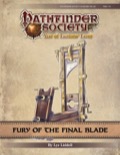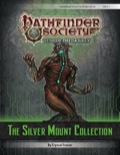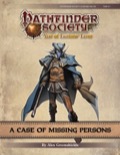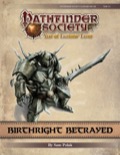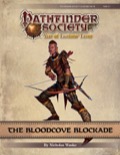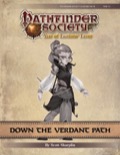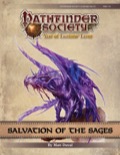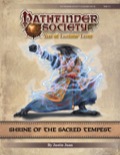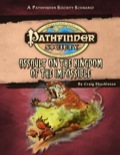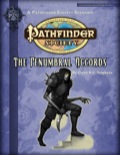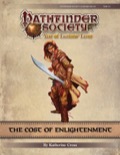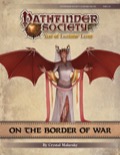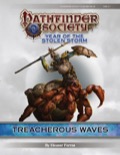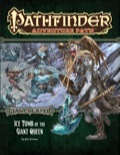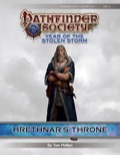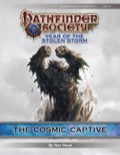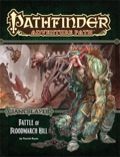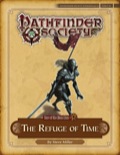Sign in to create or edit a product review. This is perhaps the best gaming I have experienced in Pathfinder Society. Literally, this is the best module/scenario ever. 5 stars. And yet, the other reviews here paint it as a TERRIBLE product. And to some degree, they are right. I'm going to explain how this is both the best & worst game ever. I'm going to spoiler most of this, but I'm going to leave the first part visible to players & GMs. That is: this is a TPK in the high tier. If you play high tier, you are supposed to die, full stop. Just do NOT play high tier. Change your characters, bring in levels 7/8/9, stay low tier. If you do this, the game immediately switches from "unfair garbage" to "hey that was fun." And now we'll get into spoilers where I explain why, and I'll respond to some reviewers previous comments. Spoiler:
Here is why the high-tier TPK'd or almost-TPK'd players in the previous reviews. Take your level 10 or 11 character, the one you wish to use in this scenario. Look at the hit points. Now, subtract about 20 or 30 HP. That's because the TPK fight will damage you a little, at first. OK? Character still fine? Now, subtract 140 points of damage. Is your character still alive & conscious? If so, you can survive the monster's special ability, which does a flat 140 points of damage if you fail the save. AND the saving throw DC is high. So the odds of failing are real. If you don't fail, an ally or two (or three!) will. Can you solo the fight against a creature that does 140 points of damage? If not, you're going to be part of the TPK.
Now, let's say your character is awesome, and let's say you meta-game against this issue and you all have protection, because you cheated. You'll still lose. Why? Because there are NPCs within range of that special ability that cannot survive it, and that means that even if you live, you'll lose all your prestige and essentially "fail" the game. This is why people are upset with this product. However, my games never had this problem. Why? Because we heeded the prior reviews and we all agreed to play low tier (both for the game in which I was a player, and the game in which I was the GM). Low tier has exactly zero problems! The monsters are tough, but not unfair. And the monsters have no guaranteed way to insta-kill the NPCs you are protecting. Much better! Now let's get into some comments from previous reviews: Quote: "this one doesn't allow you to prepare at all, and you're thrust in unprepared into a deadly encounter." ...and... Quote: "There's an investigation bit earlier, but it has little to no bearing on the outcome whatsoever." So this is where I started to mutter, "huh?" as I read the previous reviews. The investigation, which supposedly does no good, is specifically there to give you information so that you can prepare for the deadly encounter. When a reviewer says this: Quote: "Nothing significant comes of the investigations and it doesn't help your prison encounter at all." ...I have to wonder what in the world they did during their investigation. Listen, previous reviewer, this may bum you out to hear this, but I think your GM might have not read the product fully. I think you might have been ripped off. The module specifically calls out that PCs can learn of the wards inside the jail, including an evil summoning circle!!! AND the PCs can learn that the jail is supposedly haunted. If PCs cannot put together that ghostly/incorporeal monsters are being summoned in and/or controlled by a magic circle, then the fault is not with this product. It borderline bangs you over the head with these hints. The only issue? The hints are explained in the many paragraphs of text about the jail. So GMs have to actually read the paragraphs and know this, or highlight the text, or do something so that they know what they can convey to the players. Skimming means you'll miss this and ruin it for your players. I want to make that more blunt: if you are the GM and you skim this product, you will miss a ton of stuff and ruin it for your players, and that will be your fault. Don't do it. As another reviewer wrote: Quote: "there’s at least some chance that you can figure out what’s coming, and if you make the right preparations then the fight is significantly easier." So, do a real investigation, scope out the jail, learn what you can, and prepare. GMs, this next bit is for you: stop hiding/withholding information. When I first read the product, I saw that the PCs could learn about the magical wards, and I thought "There is no way. Even if they can, they won't." Think about this. If the jail is reinforced stone WITH LEAD LINING on the inner cells, as described in the product, and if Detect Magic/Evil/Undead is foiled by thick stone and/or lead lining, then what player on Earth would ever think to say "I scan with Detect Magic"??? It's useless. So nobody will ever learn of the wards and magic circle. But here's the tip for GMs, which makes it more plausible. First, the lead is lining only the walls of the cells. The magic circle is outside of that. So Detect Magic and other things should be able to pierce the outer "normal" walls and see that evil magic, by one of two ways -- either the walls aren't thick, or there are tiny barred windows high up (say, 7' up) to allow airflow & sunlight inside. Also the exit door is made of wood which won't seal air-tight. A Message spell should absolutely wind its way through the door cracks. You could ask for a Spellcraft (or Knowledge Arcana) check to know that Detect spells might work. No need to keep the players in the dark, if their characters might be very shrewd and might notice details about the construction. As a GM, you must be prepared for players to find ways around the wards of the jail. And I don't just mean the lead-lined walls. One PC turned into an earth elemental. Well, the jail has nothing to protect against earth-glide. You could say that the lead lining is impassable, or that the reinforced masonry includes so much metal that an elemental cannot get through, but an elemental can punch right through lead, and can also dive down underground and then back up through the floors (note: the reinforced masonry is the walls not the flooring, so some plausible methods of entry may exist for earth-gliding or burrowing creatures). Earth elementals, tiny birds (if you agreed that there are small barred windows to allow air & sunlight in), incorporeal creatures, invisibility, and spells like Gaseous Form -- they all allow for entry/exit in various ways, so figure out how to deal with it. And "deal with it" might mean, "the players did something unexpected and invalidated the enemy tactics." That's OK. Figuring out what happens when the players get creative is very fun. My players simply came into the jail with the key and a Gray Gardeners mask, acting like a guard with a prisoner. I was inclined to force this to fail, until the prisoner found a way to annoy the guards into throwing him into jail. The PCs had Message running, so they were able to stand outside the jail and get a detailed report of the layout and how freaked out the guards were about this magical/evil summoning zone. The GM's job is not to bar stuff like this and force everyone onto a railroad. The GM's job is to use as much of the module text as possible, and stay on the rails when the players stay on rails, but if the PCs do something unusual that should work, then the GM should make sure that it plausibly does work. Quote: "They were able to escape with the prisoners and the final blade when there was only 1 door and we had the prison surrounded, and a spy network setup in the city. An entire mob gathered at the execution site before we even KNEW about the execution. Ridiculous." YES, this is true. This is what I was saying. This problem is not with the product so much as it is with GMs who are too rigid or who are scared to do anything other than exactly what the product's author mentions. If a GM is so nervous about this that they force the players actions to be invalidated -- even though PFS rules talk about the opposite; the players being able to invalidate the module text -- then that GM is not following the spirit of the rules. The rules say "don't change monster stat blocks," but they do NOT say, "players can only choose 1 path and no other ideas will work." Also, to address the quote that I just... quoted... I would like to note that in my game, the players put a spy into the jail long before morning. The correct answer to this is not, "No," but instead, "Okay, time to figure out what happens." They got to see Colson getting moved. They got to see the Final Blade being loaded onto a wagon in the dead of night. The module doesn't expect this, of course, but it also doesn't bar this. So now the PCs went on a raid against a wagon moving down the street, and ended up fighting both the final fight and the guards of the jail at the same time. This is allowed in Pathfinder Society. GMs, do not be afraid to deal with your players coming up with cool ideas that circumvent the expected "normal" play through. Quote: "And then we had a finale where the success is based on one die roll." Just.. FYI... this isn't in the module. I'm looking at it now and the final fight can be solved a lot of ways. Yes, you can indeed do a battle of speaking (your Diplomacy to counter the enemy's speech) and try to disperse the crowd. In some sense, that would be simple skill checks to win. However, you have TEN rounds to make this happen,¹ and if it's not working, you can certainly do anything else you think up! Fireball every damn citizen that comprises the mob. Murder the evil leader who is working them up. Even try to destroy the Final Blade! (Note: there is a post on the GM forum that suggests that the PCs are not supposed to be able to destroy this blade. However, previously Final Blades were artifacts that had 200 HP and 20 hardness. While that's VERY sturdy, it's not impossible to break.² A GM might consider that as an option too. Conveniently, when a Final Blade's hit points reach zero, it releases all the souls it has captured, including some that attack. This is a perfect time to trigger the banshee jail monster fight, if the players managed to bypass that! Or just say it broke and call it good.) ¹ = It is possible that a GM would see "you have 10 rounds" and, knowing that Diplomacy takes 10 rounds to activate (your character "must speak for at least 1 minute" before getting to roll a Diplomacy check), give the players just ONE check to avert disaster. However, the product does NOT follow that rule. It's a mini-game in which you can make a Bluff, Diplomacy, or Intimidate check as a standard action. You get ten tries to talk down the crowds, ten skill check rolls, and that's per person. Or, cast spells, start fighting, attack the guillotine, whatever. ² = Actually, this is pretty difficult to defeat. Your player with the adamantine weapon will cheerfully suggest that the weapon ignores hardness, and go to work destroying the Final Blade. However, adamantine weapons ignore hardness of 19 and lower. The moment an item has hardness of 20 or more, the adamantine is outclassed and can no longer ignore the hardness. So the PCs in your game will need to do a TON of damage on each hit, to bring this monster of a machine down. All in all, I think there are a lot of cool outcomes for this adventure. Don't let a lackluster GM rob you of all the good options you can try here. It really should be a great time, and a wild rescue. By "scary" I do not mean "haunted" or "ghosts." I mean, this module/scenario has a reputation for being difficult. See the previous reviews. Some will tell you it's unfair or ends in a TPK. To be fair, when I was a player in this module, there was indeed death (but no TPK), so it IS a rough one. However, I just ran the scenario and nobody died. I did do a lot of damage, though, and I wasn't trying hard. Let's talk about some of the details: Spoiler:
The oozes - when I played in this game, the oozes were scary for being oozes, but the GM wasn't tracking the piercing/slashing damage, and never had the oozes get bigger. So, as a player this fight was so-so. However, running the game as the GM, I tracked this carefully. One of the oozes got bigger twice, although the other oozes did not because the players caught on and began to switch to blunt weapons. Nonetheless, the fight was difficult -- I hit 4 of the 6 PCs multiple times, and I got 3 PCs with grab/grapple/constrict.
At one weird point, all 3 oozes were in negative HP, but I had to keep the initiative running, because all 3 could potentially get back up due to their regeneration, and in fact the big one did. Monsters that can get back up after getting knocked out will always make for a tougher encounter. If you are a GM, know that this is very difficult to juggle. The growth stacks. So twice I had to increase the monster's STR/CON/HP and I did that live, and I did it badly. The monsters should have been stronger and done more damage -- I was focused on giving the monsters the extra HP and short-changed the other parts. It wasn't intentional, and the PCs needed me to screw up so that the fight wasn't miserable. But if there is an option to pre-print the stat blocks in ALL their expanded forms, I absolutely would do that next time, just to save me the trouble of quickly re-calculating stats on the fly. Also, having to track if the monsters were hit by piercing/slashing/fire/acid was definitely a bit more paperwork. So watch out for this fight. Pendleton/silver swarm - this fight is brutal, and it's possible that if I had not called the fight, it would have gone very badly for the group, based upon their fight with the oozes. The silver swarm has the ability to fully recharge the gearsman robot that protects it. So the fight isn't just "beat up Pendleton so that you can beat up the silver swarm, but hopefully don't kill Pendleton." Instead, it's that issue plus this damn robot that keeps getting back up. AND it can heal itself too. The amount of hits this boss fight can endure is really high, and it can drag out the final encounter quite a bit. In addition, you're not really supposed to tell the players that killing Pendleton will cause them to lose prestige points. So this is difficult to suss out in the middle of combat. You'd have to realize who you're up against, which isn't disclosed, AND while Pendleton is possessed by the silver swarm he cannot speak (and the swarm itself speaks a language that no PC will likely have). Good luck even knowing that it IS Pendleton. However, if you get that, you'd still need to figure out a way to harm the swarm without killing Pendleton. Although I didn't run this fight, I told my players about this aspect of it, and one asked, "Well how do you do it?" And I replied that that's the trick. You just don't know so you have to experiment, mid fight. Make knowledge checks, use logic, etc. This is a good way to kill the poor guy if you cannot figure it out fast enough. In the GM discussion a lot of GMs insisted that the swarm will leave Pendleton once he is knocked out. But this isn't true, and in the GM forum, that misconception was corrected. The swarm won't exit Pendleton until he's dead. So the temptation to kill Pendleton is high. People will lose prestige, and I bet some of the prior reviews will tell you that the product sucks for exactly that reason. It didn't bother me, but then again I had to cut the fight short due to the store closing, so I didn't remove prestige from my players' Chronicle sheets. Overall, I'd say that the module, at least in low tier, feels like it's on hard mode. GMs, my advice is to remind the players that they are in Absalom, and NOTHING in the module suggests that they must remain in the museum, on a timer. They absolutely can retreat, purchase gear, and try again. Oh! Also, the Venture Agent running my local store says she's run this multiple times and always ended it in 4 hours. There is no way I could do that. I actually had the map on a giant flat-screen TV that we used as a table, and we had fog-of-war over the map, so as they opened doors I'd reveal only that particular room. Going room-by-room on 2 separate maps (with 2 extra not-made maps of the basement and a living area) just took waaaayy too much time. I needed 6 hours. I could have crammed down to 5 hours. For me, 4 hours would require too much hand-holding or railroading. I can't do it fast enough, with everything in the product (2 or 3 social interactions & 5 or 6 fights, 3 of which are HARD -- I can't run all that in 4 hours unless I'm leading the players by their noses). So I'm going to dock 1 star for the length & difficulty. However, I still like it anyway; I really enjoyed this exploration of the museum. If we could do halves, I'd give this 3.5 stars. I played this back when it came out, and then just last night I was the GM for a group of 5 players. This is an investigation module. You're going to get a list of "suspects" or perhaps better worded is... "persons of interest." You'll head out to interview many NPCs, do a LOT of talking, and a LOT of skill checks. There is some rough & tumble action here for brute-force dummies, but it's sparse. You really want to bring a PC that can at least attempt to Aid Another on a few skills. Also, this is one of those "pay attention and write down leads and hints" kind of scenarios. If you don't like that stuff, take a pass. One of the players, at the end of the game night, said it was good that I was running it, as some other GMs might have shortchanged the role play, perhaps just asking for a handful of skill checks and then moving on. In my case, I spoke as if I were the NPCs, and I challenged the players to hit upon the key points that each NPC cared about. I didn't call for skill rolls until they earned it with some good back & forth banter, and I didn't give them the info they wanted unless they backed up their words with great rolls. And OH MY did they ever get good rolls. All the investigation probably took 2 hours of real-world time. Then they were off to put their information to use. Interestingly, this could have been 3 hours of bloodshed, but these role players found ways to avoid almost all of that. And the scenario works fine with that! I really enjoyed playing these NPCs. Particularly Fiffernetter. I won't give away who she is, but she's very enjoyable to play as an unlikely cross between Dolores Umbridge (Harry Potter series) and Dorothy (The Wizard of Oz). She was great fun. Also, I really enjoyed a "trick" the scenario uses for the NPC interactions (spoiler): Spoiler:
After the game, the players asked how in the world they were supposed to get some information. They didn't exhaust all their leads (if they had, we would have run very late), but even still, the "trick" was something they never discovered. That is, they can ask an NPC about a topic and learn nothing, then go to another NPC and get a little bit of info, and then take that back to the original NPC and they will spill the beans. Nobody thought to backtrack and try re-interviewing leads. I thought it was clever, but also time-consuming. Having heaped some praise on this, let's talk about the 2 major issues I have with it. The first is the time limitation. We're trying to run an open-ended investigation game in a 4-hour time slot, but there is enough material here for 6 hours of game play. The last set-piece encounter/thing you do can be approached a dozen different ways, with a brute-force dumbed-down charge, or a nuanced stealthy recon mission followed by deception and more lengthy social interactions. Anything in between those extremes is also likely and the product even covers a lot of possibilities. This alone could take an hour or more, yet we were already at the 4+ hour mark when we got to the endgame. That's ridiculous. I did see some reviews saying the game runs short. I don't know how that is possible unless you're doing exactly what my player dreads -- you short-change all the investigation work down to just "Roll these 5 skill checks and I'll give you an info dump." If you're doing that, I guess maybe you have to in a tight time slot, but it really seems like it bypasses pages & pages of the author's work. The 2nd issue? It's discussed in the GM discussion forum for this product. That is, if you follow the rules of the module, you are mandated to have the players fail their mission. I'll briefly summarize it here, but the GM forum is a better place for this: Spoiler:
The PCs are on a timer. They must rescue someone and get back to their ally in town before sundown. However, it's about 9 hours until sundown, but it takes 10 hours to rescue the captive -- and 10 hours assumes an otherworldly best-case scenario. More likely, you can expect the PCs to put in hours of investigation before they head out to save the person in question. They will arrive back in town many hours after sundown, only to see that their ally was guillotined while they were gone.
My suspicion is that this is not the author trying to be a jerk. I suspect this is the author or the editors being really bad at math. For my part, I refused to auto-fail the players. I gave them the "good" option (the "good" option says that if the players hide their ally or advise their ally on how to hide, then the timer mostly doesn't matter, as it buys them a full extra day). My problem is not with the good option. My problem is that if the players didn't hide their ally, then there is no reason to track the timing or speed of the PCs, as it's impossible to succeed, even as the product implores the GM to track time and see if they can make it. They can't. It's futile. Despite the 2 flaws, I had an incredible time with this product. I had a lot of fun, lots of memorable characters, and a great story as well. It's just a great time. I'd give it 5 stars, then dock 1 star for the flaws, and we're left with a 4-star product. Thank you Paizo for a great game. When our group sat down to play this, I had 2 characters of the appropriate level: a paladin or a wizard. I wanted to play the paladin, but the group urged me to play my wizard, since the wizard has maxed-out knowledge skills. I conceded. By the end of the module, it was clear that it was a great decision. This game does have fights, and in fact one fight would have killed my wizard if it were not for a healer doing a life-lock thing (I'm not sure what it's called, but he took half my hit point damage through some magical connection he set up). However, the fights were surmountable. The real issue was the skills. We realized by the end that without the wizard, it would have been VERY difficult to pass. If everyone at the table is low in skills, you're gonna have a bad time. Despite this issue, I had a good time. There are some very weird things going on. You'll play through something like a dreamscape, but not really (it doesn't use the rules for dreamscapes because it's not actually that thing, but it's just an odd environment). I liked it being weird. Because you can talk your way out of a fight or two, this product is very swingy in terms of time played. You could end it in 3 hours if you absolutely nailed the skills & talking/peacemaking. If everything goes wrong and your characters really struggle, it could take 6 hours. My suspicion is that this is a 3-star product, but that I felt like it was a 4-star product because my GM was running it in a very enjoyable way (she play-acted the monsters, had ridiculous character-to-monster conversations, and so on). However, I can see that the other reviews also place it at 4 stars, so maybe it wasn't all my GM. Maybe the product itself rises above the average. I have not read this, and have not run this. I was merely a player. It was a very odd game. One of us used a grippli boon and could only be healed by negative energy. I used a kobold boon to play a pre-gen kobold character who happened to only be able to channel negative energy. We had a pre-gen arcanist, and a pre-gen warpriest. Levels 3, 4, 4, and 4. Despite the pre-gens, all of us have been playing for years. The beginning was a big struggle for our team. It was difficult to get initial information and interview NPCs because, well, we were a party of frogs and lizard-men and such. In addition, we weren't super-optimized. Spoiler about that: Spoiler:
There is at least one DC in here of 30. At least according to the GM, who said our 31 "barely made it." That seems a little high for a tier 1-5 product. If that's true, this product really is made for optimizers, and that just wasn't us. Or maybe it's made with the assumption of 6 players all doing Aid-Another to super-boost a leading character's results. I'm not sure. What I do know is that many of our skill check results were hovering around 12-22. I suspect at least once the GM just gave us info even though we were too low (our "best" result for a particular check was 8, and it seemed like the game couldn't continue without certain info dumps, so he sorta gave us an unusually good result for getting only an 8). So after struggling for probably over an hour at the table, just trying to move our PCs through investigations and conversations, we finally started to piece some things together. It turns out, this product is one of those "open-ended investigation" scenarios. However, we seem to have done many things out of order. We kept getting nowhere with certain NPCs, then we'd talk to another NPC later on who would suggest we go back to the 1st NPC. Eventually we got it, but it was NOT smooth sailing. Fair warning to those who come at this without a PC optimized for sleuthing. Also, even though it's open-ended, understand that the product seems to have a preferred order, and we couldn't guess it. We only had 2 fights for the entire game. And one of those fights maybe shouldn't happen. Spoiler about that: Spoiler:
At the end, a bad guy is backed into a corner by a crowd, and this bad guy reaches for a chest, opens it, and unleashes a terrible thing. Yet it is all delivered via monologue, via read-aloud text. However, none of our PCs trusted this NPC, and we kept interrupting to try to shut him up and stop his actions. Our GM was wonderful but also new, and didn't really seem to find anything in the text for handling this issue. In the end he agreed to allow us to zap this certain someone and stop him from opening the chest (the bad guy then disappeared), but then the chest unlocked itself and the terrible outcome happened anyway. Our GM seemed to think it was sort-of an inevitable situation that the product forces.
I really feel like something needs improving there. We were at the event with this bad guy because we were presenting evidence of bad/illegal activity, and the idea that we'd allow this NPC to talk for quite a while and then move to a chest and then open it and unleash bad stuff just strikes me as very railroady. Hopefully the author of this product actually has text in there to handle when a group intervenes. But if it doesn't have handling for that, it NEEDS it. Despite any issues, I had a fun time. I love investigation scenarios. I may buy the product just to read it & think about how I'd run things. It seems creative and possibly NPC-heavy (or role-play heavy). Also, note that this one may run long. EDIT: I've now read the other reviews before mine, and it seems my gut feeling was on the right path: the product DOES have "only one right way to do things" as an issue. In the very first review, it notes that PCs are admonished to follow the law, but then gives no legal way to accomplish some things. In the 3rd review, it notes that you should speak to one particular NPC first but since it's open-ended the PCs would never know to do that. I'm going to set my review to 4 stars instead of 5, because this seems to be a theme in the product that should have been dealt with. It made my play-through awkward/troublesome, and apparently bothered others too, but it's still a good product. OK, this isn't Star Wars. Maybe "princess" and "empire" is a bit much. I probably titled this incorrectly. This is not a spoiler, as it's the introductory text, but the basic gist here is: the PCs are tasked with digging up dirt on the Aspis Consortium, and sharing that information with rebels in the hopes that it will disrupt trade. Somewhere in there might be a daring rescue. For my group, we bungled our initial attempts to (peacefully) extract information. It was doubly difficult because there was a lawful good healer in the group AND a paladin. We couldn't be stealthy, sneaky, or deceptive. Having said that, we pushed through and in the end we got enough data to enter into negotiations and/or "persuasive talks" with a couple of important NPCs, and managed to win them to our cause. As you might expect from a Pathfinder Society product, these NPCs quested us with "jobs" to do to help them before they would fully ally with us. I have yet to read the PDF, but my impression from playing is that this is at least a little bit of a sandbox. Our GM spent a good portion of the night asking, "So, what do you want to do next?" I didn't feel like I was on a railroad -- we had a handful of leads & things to do right at the start and we didn't seem to experience much limitation as to order of events. This open-endedness may have caused the game to run a little long. The combat encounters for this product are quite enjoyable. At least for me, there were conditions and status effects (high tier) that caused: Spoiler:
...limitations to movement or penalties for doing certain actions, and it made the encounters seem dynamic and interesting. Three different PCs could channel energy in our group, so the fights never put anyone in danger, but having to deal with terrain & cover & so on was a nice wildcard to add to the encounter challenge. For GMs: Spoiler:
We had some issues in our game:
So, in another Pathfinder Society product (9-05, Call of the Copper Gate) a reviewer wrote this under his objections: Spoiler:
"First, the initial assumption that the PCs are going to obey Zarta Dralneen, instead of arresting, killing, or snubbing her. This is a half-loved, half-despised character, and should not be giving direct orders to regular Pathfinders." OK, take that review text, swap Zarta for Jamila and poof, you have a review of this product.
Yes, the Jamila from the Tyranny of Winds trilogy, the Jamila that betrayed Pathfinder Society, stole artifacts, caused deaths, and ultimately needed Pathfinders to bail her out -- that's the person here, giving orders. Also, she's asking everyone to convert to the new Concordance faction. Essentially, a possibly hated figure is jauntily, happily trotting along with the group, making bets and joking. For my character, I viewed this NPC as a total thief & betrayer. I never felt that the authors of those previous products rehabilitated her character very well. I spent most of the game trying to get her removed from the adventure, and failing (it's railroaded in, she has to follow along). If you loved her, this will be a delight for you. If you were neutral about her, this will be a delight for you. If you think she deserves a hearty punch in the face, well, prepare to fail your mission. OK, enough of that aspect. Let's tear that band-aid off and be done with it. Ouch. Once over that hurdle, what's the basic summary here? What does this product bring to the table? Well, the summary is that you are summoned to a region because, as the title implies, things are getting too verdant there. People are worried that something has gone awry magically. So you head out to investigate, with the betrayer in tow. During your investigations you'll have a couple of encounters that the betrayer won't help you overcome at all, you'll be asked to aid someone with a side-quest that isn't relevant to your quest at all, but you'll meta-game and know that you have to do the side-quest to achieve your main quest goal, and so you will, and then you'll win. Get those prestige points, baby! OK, now without sarcasm and with more detail: Spoiler:
You'll find a verdant area and fight monsters, while Jamila just moves out of the way and leaves you to deal with it on your own. I am very happy I didn't play this module with a particular friend of mine. He has a military background and pushes this concept of "dereliction of duty." The idea is that if you are faced with a danger/challenge and you shirk away, you may find yourself on the dangerous end of a gun, as your commanding officer gives you the option to engage in combat or die. This friend of mine would be murdering Jamila the moment she walks away from the encounter.
For GMs, this might be an excellent reason to not force her to attend. I haven't read the module, but she does have a partner who also attends: Falbin. Perhaps he is the only one needed here, but I don't know. If the players at your table do not care about "dereliction of duty" then they won't care when Jamila backs away. They'll understand that meta-game dictates that she leave the fight to the PCs, and so the players will carry on fine. However, that brings me to my last spoilered point. The meta-game. Later in the game, a gnome is going to ask to get his/her blues & indigos back. It sounds silly, sounds like maybe it has to do with the "bleaching" that gnomes sometimes experience, and it doesn't seem tied to the mission at hand. Unfortunately, it totally is. So the players have to meta-game. The realistic response to the gnome's request to "get my colors" should be "Hey, thanks for the side-quest, but we're on a mission right now, so maybe later." In fact, this is what my character said. Instead, you're supposed to wink-wink, nudge-nudge -- we all know that this is the real plot, so dive in. If you're a GM, please try to find a plausible way to tie that side-quest into the main quest. Yes, it's cute & whimsical, but it also comes across like a distraction. Any connection would make the players feel more inclined to say yes. So, let me close with some positive comments. I think the fights have the potential to be interesting. I think being able to negotiate out of a couple of the fights is also interesting, although the DC to do this wasn't something my group could achieve. (I'm surprised there can be any check at all, however. By the rules, Diplomacy takes a full minute (10 rounds) of talking before you can make your roll to win someone over. Typically, 10 rounds is long enough for a combat encounter to run its course. At that point, the Diplomacy check is redundant; everything is already resolved. So allowing fights to be swayed by 1 or 2 rounds of talking is impressive.) Lastly, there is a mechanism in this product that can separate the party members and force them to have to fend for themselves for a short period of time. I found that to be exciting. I would like to run that as a GM, and see how various groups handle it. Overall, this is a great product if you have no hangups and can just go with the fun. However, I was badly hung up on the villain that we had to obey in this product, and badly hung up on the "silly side quest that is actually your main quest" subplot. For me, issues such as these pull the rating down to a 3 star product. I cannot wait to see how others rate this. Oh, one last thing. It might need spoilering, but it is one of those things that could make some people really upset, so it needs a warning up front so players can opt out. In another scenario from season 9, there was a big push about a lesbian married couple that figured prominently into the game. Some people hated that, some loved it. Well, here there is a gender identity "thing": a character is going to be called a him or her by the players, and then the NPC is supposed to say, "Sorry, I'm non-binary." For us, we had to figure out what that even meant. Once we "got it," it sure felt like someone was pushing an agenda. I'm not going to rate the product up or down for this, but YMMV. Aw hell, here's an edit: Spoiler:
I'm starting to think that the Paizo team is suffering from a disconnect from the fans. And no, I'm not talking about making an issue out of gender in what should be a product focused on fantasy sword & sorcery. I'm talking about Jamila. Over in the product discussion, someone wrote, "The Concordance? Those despicable thieves who didn't have the courtesy of trying to speak with us before they attacked us, stole from us, and then needed our help to bail them out of their stupidity? The rest of you may trust them, but I would trust a Spawn of Rovagug first."
I have to admit, this is now the 3rd or 4th time this season that Paizo has dropped a controversial jerk of an NPC onto the players, and some players are having a legitimately difficult time with this. I'm really starting to wonder if maybe players should just start murdering these villains hanging out in the Pathfinder lodges, accept some mission failures, and send that word back to Paizo. Is Paizo aware that we don't view these characters positively? It feels like Paizo loves them and thinks they're beloved. Hey Paizo: they're not beloved anymore. You can't have them put Pathfinder Society in danger and think that all the players are going to be forgiving. Your products are starting to be unenjoyable when you do this. Please think about this. At the very least, you need to have a contingency in the modules for what to do when the PCs predictably want to shank your reviled leaders. EDIT #2: I've lowered my rating to 2 stars. This product has left such a bad taste in my mouth, and Jamila/Concordance in particular is so bad (in my opinion) that I just cannot get over how much I dislike this product even 3 months later. I'm sorry about that. I can see that other reviewers clearly loved it. I just... I can't go there with you all. Sorry. So I had a great time playing this module/scenario last night. Yet I'm only giving it 2 stars. Let me explain why. First, you need to know this is an adventure in the Tien section of the map, an area comparable to Asian countries in the real world, with foreign languages (at least to Absalom-dwelling Pathfinders) and bird people (tengus). The social interactions at the start of the game were enjoyable. A few people got to shine, including myself, as my Tian-Min druid was our designated translator. We had a bard who specialized in tea ceremonies, which made him particularly useful for social activities. We enjoyed meeting some of the local tengus, and learning of their upcoming "chosen one" religious ceremony. So far, so good. Except... I couldn't help thinking of another scenario: Spoiler:
8-14 - To Seal the Shadow (a wayang puppet story). This is almost literally the same concept, sans puppets. In fact I've put this in a spoiler because once you know this, then pretty much you know this entire product, including plot twists, right to the end.
In fact, something really surprised me during the game last night. Upon learning what was at issue for the tengus, a player at the table said, "And of course this ceremony will be spoiled by the corrupt stormy dudes." That felt like deja-vu, and so I looked at my review of 8-14 and what do you know? I wrote this: "The whole 'puppet ceremony is interrupted because somebody goes crazy and tries to unleash the ultimate evil' thing? Yeah, totally predictable. And, entirely contrived." And so if it's a super-obvious twist there, it's a super-obvious twist here. Our final "boss fight" was hilariously underwhelming, and that's not a dig at the product. The bad guys taunted us, our barbarian got to act first, and he charged & landed a crit with a greataxe (x3), doing about 55 points of damage in a single hit. The 1st enemy was down. The next enemy took a turn, provoked AOO, the barbarian got another crit, and insta-killed the 2nd bad boss dude. Literally the entire final encounter took a few moments as crits were resolved, people cheered and laughed in disbelief, and that was it. It was very fun and funny. And that had little to do with the module. It was all due to the gang at the table. And I feel that "it was all due to the gang at the table" was the theme of the night. Did the scenario provide some good NPCs to talk to? Well, it provided NPCs -- I won't care if I meet any of them again, but the players made it fun. Did the scenario provide a good story? Well, it did provide something, but we were all joking about the plot twists within minutes of starting the game, and players had called the boss fight 4 hours before it happened. Part of the amusement was watching players try to get to the bad guy before we were allowed. We all tried to jump the railroading. It was a great time, due to fun people. So the product pales, even despite my attempt to make this scenario personally more relevant. How? I took my druid, which had never been played before, and changed his backstory to be Tian-Min. I gave him the relevant languages. I had the GM agree that I was picked up for this mission as a translator, a local working in the area. My character didn't initially know what Pathfinder Society was, but essentially got "roped into it" and then stayed in it. Yet all this effort to tie myself into this module didn't really help -- I mean, it worked at the table, of course, but it didn't make the game any more interesting. Essentially, the setting feels like it could have worked anywhere. The story doesn't need tengu society to work, nor does it have much regional flavor. Perhaps that's unfair -- there is read-aloud text that is evocative of the region. What I mean to suggest is that some read-aloud text and tea parties is pretty much all there is. You could strip that out and re-skin it as a Mwangi plot/story with little effort. In the end, I feel like the product is very "okay-ish." It works. But you have seen this before. You or people at your table will predict everything. Your interactions with NPCs will be fine, but not memorable. If an NPC here is going to be memorable, it will likely require a 2nd product that makes them more interesting, thus giving us rose-tinted glasses to look back at these NPCs and re-characterize them as more vital than they are now. An interesting side-note about this: Spoiler:
There was some cool flavor about the interactions with the tengu. At one point, the GM described our winning the approval of a crowd of tengu as a "ruffle of feathers" as they all sorta shook or rubbed their wings, creating this windy sound that he characterized as applause. We all sorta stopped, and one player said, "Is that in the module? Like, tengu society applauds with a shuffle of wings, making this cool feather-fall sound?" The GM apologized, "No, I just made that up." Oh. The one cool thing we liked about their society wasn't even in the product at all. That seems par for the course, here. The scenario is a decent framework, but it needs a good GM to paint the details. When those details are painted, you have to credit the painter, not the product. I played this module/scenario years ago, mostly forgotten. I had a chance to run it recently, but only had about 1 day notice that I would be doing it, and I was only able to get about 3 hours to prep. This meant I couldn't even read the GM forum -- I had enough time to read & highlight the module, to make maps, and that was it. In some cases, I couldn't even prep enemy stat blocks. For example: Spoiler:
I had no idea of the saving throw DC for a monk's stunning fist. I had no idea if constructs could be sneak-attacked. No biggie, but usually I'm over-prepared, and in this case I was looking things up on my cell phone as we played. Having said that, it was still a pretty OK game. The gang said they had fun. And it didn't run long. This should tell GMs something: this game doesn't need a huge amount of prep time, and it'll easily fit into a 4 hour time slot. I even ran the optional encounter. Still ended on time. One of the great things about this super-simple module is that it was on the leading edge for one big aspect of the game. It did something 8 years ago that most scenarios nowadays take for granted (modules didn't always embrace this back then): Spoiler:
It allows for Diplomacy/Intimidate/Bluff to short-circuit some encounters. You don't have to fight. I tried to encourage fighting by having the bad guys pull out weapons and get very hostile (without actually taking a swing). Even still, some of the players saw through the hostility, and could sense that the bad guys were scared/nervous/underpaid, and just wanted out. They bargained hard wherever they could sense an opening. They still had a few fights, but they skipped 2 (including the boss fight!) and let a few bad guys go free. I felt like the players really "earned" their Diplomatic options, because I didn't lead them down that path -- I did let on that the bad guys were scared at one point, but I did keep having the bad guys grab weapons and act dangerous. So when the players chose to negotiate, I felt like they really were trying for it, and when they pulled it off, they really earned it. One thing about this module that was entertaining: the fights were difficult. Nobody died, but characters kept falling unconscious. What was doubly interesting is that the team had a couple level 3s but were in low tier, so they were overpowered for this module. However, I got lucky, and the terrain is better than previous reviews have let on. Here is the lucky part: Spoiler:
The PCs split themselves up for the monk statue fight -- some outside of the keep, some inside. In addition, they failed the Perception checks, so I gave these monks a surprise round to really try to make it dangerous. That helped make the fight more challenging, but the PCs still overcame it handily. However, see the next spoiler. And here is the terrain part, which I think every GM should read: Spoiler:
The main advance on the keep can be brutal. Yes, the players can Stealth in. However, GMs shouldn't be giving that away. Stealth requires declaring it; you move at half speed, you duck behind obstacles, etc. I kept asking about their approach, but I never called for a Stealth check or even suggested it -- that part is up to them. So my players? They didn't duck behind anything. In fact, they started buffing themselves about 35' or 40' away from the walls. So yeah, they got caught.
Here is where terrain can make some 1st level enemy grunts into a serious fight for 3rd level PCs. The scenario text states that the approach to the keep is difficult terrain, as it's a steep hill to the keep's walls. In addition, the archers are on the walls, above the range of reach weapons. So as the PCs were noticed and shot at, they started running toward the keep, but had to spend 10' of movement for each square they crossed (this is not me making this up; this is in the module). So they were out in the open for round 1 & 2 of the fight! They got shot. One PC went down. When they finally got inside, they saw the ladder and ran to it. However, the enemy ran to the ladder and pushed it over while the PCs were mid-climb! The module doesn't dictate that I do that, but it made obvious sense. The archers want to shoot the melee brutes while they're down on the ground. So of course they blocked the brute from getting up on the walls. This gave the archers another 2 rounds of shots. I did improvise in favor of the players, a little bit. Because the walls were crumbling, and because the archers were leaning far over the wall in order to push away the ladder, I had at a couple points declared them as making balance checks that left them flat-footed. Some PCs used this to get up on the walls even though the enemies were blocking (enemies can't take AOO if they're flat-footed). One enemy fell off the walls. Overall it was a big loss for the bad guys, but they got a TON of arrows fired before they went down. If I hadn't imposed some balance checks, it's probable that the archers would have enjoyed another round, and maybe taken down another PC. Yes, the module is from the early days of Pathfinder. Yes, it has "old style" fights that are easily overcome by today's PCs. However, you can get a real boost in these fights if you pay attention to the maps and take into consideration the environment. In one of the encounters I didn't discuss, there is a forested area. There is nothing in the module about difficult terrain or what the forested parts mean in terms of combat rules, but there are general rules about tree trunks providing cover, and leaves providing concealment, and so on. As a GM, you can certainly give the fights a little "oomph" and still be within the rules. Most enemies don't have a lot of tricks. Most fights are "normal." This is what I mean when I suggest the module is "simple." However, it is also enjoyable, and the way the module allows PCs to handle things makes for a good time. The other reviewers are right -- the module/scenario is very straightforward. It's just this: Spoiler:
Go to the museum, reclaim the 1st floor, room by room. You don't have to worry about the basement or other levels, and you don't have much to do outside of the museum. So basically, the whole game is just getting through 6 rooms. Each room has something to deal with, and that's it. This is clearly from back in a time (2011) when Pathfinder Society actually did try to end games in 4 hours, unlike the 6-hour games they do nowadays. So why did I have more fun than other recent reviewers? I think it's because we fit into the expectations of the product quite well. That is, we only had 4 PCs, and all were middle-of-the-road support characters; they could hit a little bit, heal pretty OK, do a few spells & skills... basically nobody was optimized, and everyone was well-rounded. We all expected someone else to bring a barbarian or heavy hitter, and it just didn't materialize. So, we had 2 clerics, each at 4th level, doing sorta OK melee damage. We had a magus, but only at 2nd level. We had an alchemist at 4th. We played up. That was it. So on the very first fight, my character went down. In fact, 2 PCs went down and a summoned critter was killed. Of course with 2 clerics, there was a lot of healing to go around, so we survived. We went on to the next few rooms and the encounters were OK -- not deadly, not easy. Seemed like a good match for 4 "average joe" PCs. We did enjoy the description of the environment inside the museum. I won't spoil it for you, but something weird is going on, and you have to puzzle it together to figure out how to interact with the environment properly. Having said that, the "weird environment" is pretty much the only puzzle or non-combat thing you will do in this module. Everything else is just "swing sword, solve problems." It is NOT BAD for a simple night gaming with friends. However, it also is sorely lacking in many areas -- more modern Pathfinder Society products have discovered how to diversify and have many various challenges. This product is from a time before they learned that lesson. I had fun, but then again I changed a lot of stuff.So, we did something weird in this Pathfinder era: we went back to the D&D 3.5 edition books (which this module was written for), rolled up D&D 3.5 characters, and played through the module as it was originally intended. This has a huge effect on the game, as D&D 3.5 characters are much weaker than Pathfinder characters. So, PCs died. Some fights are tough, and the D&D characters couldn't survive it all. Using Pathfinder characters would certainly make the module a little more survivable. Nonetheless, I enjoyed the module as we played it. Here is a general summary of the module concept, for potential players. You're in the town of Falcon's Hollow, and stuff's gonna go bad, again. As this is the 4th or 5th module in this series (Hollow's Last Hope, Crown of the Kobold King, Return of the Kobold King, maybe Carnival of Tears, and finally this), your characters should be well versed in the town and its trials/tribulations. The local gravekeeper is going to seek you out, giving you just moments of advanced warning before a horror scenario strikes the town. And then, if you survive that and want the town to survive too, you'll head out to discover who was behind it, and put a stop to things once and for all. The stakes are very high. It's entirely possible to lose every single soul in town. You can screw up that badly. (Technically, that's the ending my players earned, but I did shenanigans to help them out.) Whatever you learned from the previous modules, and whatever you fought in the previous modules, and whatever feats/spells you needed in the previous modules... it's just more here. If you know what was happening in the previous modules, then brace yourself, and dive in for another helping. Don't expect anything surprisingly different. And now here is a summary of the module for GMs: Spoiler:
The gravekeeper runs to town to warn the PCs that his graves are all dug up, and a zombie horde is incoming. Then the players do "town defense" as five separate waves of zombies hit the town gates. You can make this feel like a zombie survival horror game. I actually took the town map into a photo editing program (The Gimp) and overlaid a grid on it. I made the well in town fill a 5' square exactly, which makes most houses about 20' on a side and makes the gates into town 10' or 15' wide, or so. Then, we let the players drop minis onto this huge map and run from gate to gate trying to keep the zombies from getting in.
Once that's done, it's a race back to the same monastery that the PCs have been visiting in the previous modules. Here they discover that the lower levels are now unblocked, and the entire rest of the module is a dungeon crawl. The dungeons is, just as with the previous modules, inhabited by undead. Unlike the kobold modules, there aren't a lot of traps. The interesting effect for this module is that the ultimate villain can see the PCs as they move through the dungeon, and he constantly taunts them through the undead that they fight. This also makes the final fight incredibly hard, if you as the GM want it to be. Why? The module says that having watched the PCs fight, he knows their fighting style and does whatever foils them. He seems to be weirdly able to predict their "theme" of fighting (lots of fire? all martial attacks? lots of spells that can be countered? -- whatever it is, he will be aware and try to spoil it). Now for the biggest problems: Spoiler:
The previous 4 modules in this series established Sharvaros as the gravekeeper for the town. So when this module has Verrin as the gravekeeper, I was all confused. What happened to our friend? I mean, we saved Sharvaros's kid in a previous module. We know the gravekeeper. What is this new guy doing here? (It turns out on the forums that they made this clear: the module was written by people who didn't know they were writing the 5th module in the series -- it was adapted for that -- and edited by people who were new hires and didn't know the lore or backstory.)
Aside from some initial role play with the gravekeeper, almost all the rest of the module is combat. If you have not played the previous modules, you may have no vested interest in saving the town, and no connections to the NPCs of Falcon's Hollow. This module isn't good enough to connect you and make you care, so you kind of need to play the prior modules in order to appreciate things. The entirety of combat in this module is almost exclusively undead. Not 100% but it's a VERY high percentage. If you run this module using the old D&D 3.5 rules, rogues will be miserable here. Why? Because in 3.5, rogues cannot usually sneak attack undead. But forget about rogues. Here's the real issue: your players will be sick of fighting undead by the end of this module. One of my players actually had an outburst of sorts about this, just complaining about the endless waves of undead. The other thing in abundance here? Ability damage. There are so many poisons, diseases, and similar effects. I just checked and there are at least 6 encounters that will damage your STR, DEX, CON, INT, or CHA. No wisdom damage that I saw. This got so bad that the PCs decided to leave and get gear to handle incorporeal undead and ability damage. Unfortunately, they wanted big-ticket items that would not be in Falcon's Hollow. So, they went to Olfden, but this meant they were gone for weeks. (That is where, previously in this review, I wrote that the players "earned" the ending with the town utterly destroyed. The module states: "If the PCs fail to defeat Drazmorg, he continues to build his undead armies and fortify the Vault. When its residual energy is depleted (taking 3 to 4 weeks) he goes on the offensive, trying to gain additional followers by attacking Falcon’s Hollow." So technically my players should have been told the town was destroyed, or at least it was attacked while the PCs could not defend it, and virtually all citizens were killed or turned to undead. Instead, I had Drazmorg still gathering power. This was fun. I had the final fight be MUCH more difficult, but also much more of a slaughter for the PCs. What I did was to apply skeleton & zombie templates to animals and have Drazmorg having raised up a small animal army. They were VERY easy for the party cleric to turn, but there were so many that the PCs still had to move in and just clear a huge swath of them via attacks.) Also, because there are a lot of poisons and such, there are a lot of Fortitude saves. And... in my group we had a lot of strong martial types, all with high Fort saves. So guess what? Not once were they paralyzed, sickened, or any other number of effects. The module has maybe a couple of Will saves, a couple of Reflex, and then a metric TON of Fort saves. It lacks diversity so much that the module can either be a cakewalk or sheer Hell, just depending upon the party composition. Lastly, the module has a ton of editing problems. The conclusion talks about how things might go if the PCs are allied with Yras Nine-Eyes -- but that's a name that literally doesn't get mentioned until the module is over, in the Conclusion. It comes out of nowhere and is a condition that the PCs cannot have met. The module imagines a setting that really doesn't exist. This may be in part due to the module originally being intended for something else instead of being the Falcon's Hollow conclusion. Another editing problem: Drazmorg can control all the "ghasts" that are near him, except... there are none. The module put ghouls around him. Another editing problem: room 16 says it's a CR 6 challenge, but they put 2 zombies there, instead of 12, so it's a CR cakewalk unless you know to fix it. I did swap out a few monsters, just to increase diversity of fights. I did run some things differently, just to keep it from being monotonous. However, overall it was an OK conclusion to the Falcon's Hollow story arc. But it certainly could have been better. On the GM forum, I just posted a note about how complicated one of the fights is. This module has a LOT of area effects that deal all kinds of weird damage. You could end up with 2 or 3 conditions on your PC from a single fight. Your GM could have to track 5 or 6 area effects with different saves per PC as they move around. So have pity on your GM, there is a lot to manage here. ALSO, the GM who ran this module for me noted that it was a full social scenario followed by a full dungeon crawl scenario. In other words, if your GM is not rushing you, it's possible this could take almost twice as long as normal to get through. I just ran it in 5 hours myself, and to do that I skipped the optional fight, called one of the other fights halfway, and handwaved some social bits here & there to push forward. If your GM can run this faster than I did, praise them. However, if they can run it in less than 4 hours, squint at them and wonder what parts they skipped or glossed over. OK. Having said all that, here's why I rate this 5 stars. It's totally fun. I actually drew out the town on a giant grid map -- a town that isn't shown in the product, but certain buildings are described and locations are given. I needed to do this not just for enjoyment, but also how in the world do the PCs interact with so many locations and NPCs without any visualization? So much would get lost & confused in the constant verbal barrage, so I added a map with minis and I think it helped. It was very fun for me at least. I hope the players liked it too. In town you can meet a long lost ally from a previous season of Pathfinder Society. I was so excited to have a player at the table who actually took his character through the old scenario, so that they could be greeted warmly as old friends. It was enjoyable role play. Also, if any of the players at the table have ever played through the Kingmaker campaign, they'll at least be familiar with the area, and some of the backstory. The backstory is good, and it seems to make sense with older products. However, as a GM I had to write out a lot of notes about the various noble houses and their origins/alliances before I could get it clear in my head. After taking too long on the social side and still not having the full story, I urged the players on, toward the keep. The keep has a ton of stories to uncover, along with over a dozen skill checks just in the top level of the keep alone. Skill monkeys should be happy. The lower level of the keep continues the skill checks but also turns violent. Here combat gets heavy. These are the fights with many status effects & a tough final showdown. However, if you've been indulging in the previous areas, you're going to be pressed for time in these final battles, and they're complicated too. Do not shortchange these encounters! They are actually good and very enjoyable if you run them right. Keep the game on a tight timer if you must. You need at least an hour for the lower dungeon, probably more. (If your group knows about using wire halos to show which minis have which conditions, and/or maybe table tents for status effects, it'll help. Also, bring height indicators if you've got 'em.) Expect fights to be hard but not TPK-worthy. Expect skill checks to be hard but not un-achievable with work (well, my players missed some, but once they realized that they needed to put forward better numbers, they amped up and did OK with the rest of the checks). Expect social encounters to be hard if the party splits up (my group did), but easy otherwise. Overall, this module seems... dare I say it... balanced. It's tough but most groups will survive and enjoy a few successes. It's varied, it has something for everyone, it's got a good story, you get to re-meet an old ally, maybe even there is a romance there somewhere... it's just awesome overall. Try not to play this somewhere that has a tight schedule. Try not to rush. Try to play with a GM who can act out various NPCs well. Try to avoid a GM who railroads. Try to get all the info or much of the backstory. Have fun. It's a good time. One more thing, for GMs: Spoiler:
The inn/tavern in town, which Lander is staying at, is un-named in this product. I called it The Bearded Frog. I hope you also call it that, just because it's awesome. The innkeepers were Hal and June, husband and wife. Hal treated Lander sort of like a "whale" or big spender, and wanted everyone to leave him to his (expensive) wine. However, June hoped the PCs might have some advice for the young noble. Have fun! I had a great time playing this. Note that if you’re the person who arrives to a game and tunes-out the introduction, be forewarned. You’re going to tune-out for a LONG time. This is an investigation scenario. It could be an hour or two before people stop talking and any combat happens. If you’re a person who takes notes, cares about the NPCs, and talks to everyone… you’re going to have a great time. There are 4 or 5 major NPCs and a handful of side-characters that may or may not have relevance. At a certain point, time will matter, so you have to plan carefully and be willing to sacrifice or at least make tough decisions. In our game, one player was very upset that visiting the market was going to take so much time, and kept trying to argue for less time. In the end, we split up in order to cover more things more quickly, and it hurt us a little, but that was our decision. To help us out, our GM laid out colored 3" x 5" cards, each with a name of a suspicious NPC. It helped us to track who was who and also to drop extra notes down by each card, as we discovered things. We used it as a sorting system, right on the table. I see in the other reviews that the final fight is a cakewalk. For us it wasn’t. The real issue for us was: Spoiler:
We had to deal with a flood of water, which slowed movement and eventually halved weapon damage for most types of attacks. Mid-combat, we had to waste time on spells for water-breathing and other non-attack options, just to remain in the fight.
Also, as my own GM note (even though I’ve not read the module, nor run it) I’d like to remind GMs that the surface of water ruins most targeting. It grants improved cover in most cases, which is a +8 to AC, +4 to reflex, and confers the Improved Evasion feat for free (see the Core Rulebook for rules on aquatic environment and cover). So a shark which is fully in the water can easily attack someone partially in the water, but that victim cannot easily retaliate by swinging a blade from the surface into the water – which closely mirrors real life. Magical flames blasting onto the surface of water will not usually penetrate the water, either. A PC must get all the way under and target the shark from under water, and even then you’d need piercing weapons such as an underwater crossbow. Spells are expressly listed as “GM discretion” when cast under water, so you can’t expect everything to work. EDIT (July 21, 2017): Having now read and run this, I have to point out that my original GM ran this final fight wrong. It was difficult for us because he imagined that the hexagon room that we fight in was walled and when water came up, it just kept building until we were all swimming. This is totally wrong. The hexagon fighting map is docks. There are no railings. You are on wood docks, over water.
If other GMs are going easy on that stuff, I can see how that would make the final encounter a cakewalk. For me, this was simply a ton of fun, and well balanced for a "normal" party. I intend to buy the module, and run it myself. I like part 4.This is written from the perspective of a player. I've not read the module. I very much enjoyed this module. I don't know if it's typical for this, but my GM just laid out the isometric map of the entire area, and said, "This is what you see when you use Overland Flight to get a bird's eye view. There is nothing set in stone about what you must do, so... ask questions and try stuff." And then we did. We invented whatever we felt might work. At one point, I unleashed about 40 earth elementals just for the chaos of it. That kind of thing would never be possible (or fun) in tight dungeon corridors, but here in an open area, the elementals could Earth Glide unseen and make a mess of things. The GM figured out how that might affect the area, and we got some credit for inventiveness, and then moved on to other fun ideas. Basically, the whole module (except the end) is pretty much just an idea factory. Think things up, try 'em. If anything is a weakness of the module, I would say it is the open-ended gameplay itself, which I've just praised! Why? Because with an unfair or unbending GM, this becomes an exercise in futility. A bad GM might freeze up in such an open-ended game, perhaps saying "That didn't work," to anything other than combat. However, for the game I'm in, the GM accepts creative ideas. So we tested a LOT of things. Some worked, some didn't. It was a good experience. Also, if you ever wanted your character to feel heroic, one nice thing about this module is that there are a LOT of helpless captives you might be able to rescue. I don't mean, "There are a dozen captives, placed in random locations." Instead, I mean, "There are maybe hundreds of captives, and you will likely see dozens killed, but you will also free scores and scores of them." We ended up mapping out an escape route for the freed slaves, and just exploring the surrounding wilderness to figure out the safest route to civilization was an enjoyable self-imposed mini-quest. Nothing in the module mandates that you save everyone. Your mission is actually to do something else. So we just saved people because we wanted to, and the module made it possible, and enjoyable. Overall, I'd say that modules 1 & 4 in this adventure path have really been enjoyable for me. If you're feeling creative, this module might be right up your alley. ...and I'd be OK to play it a 5th time. The module can't be bad or even mediocre if I'm willing to play it so many times. I enjoy myself every time. So that's why I'm giving it 4 stars. I don't find any part of the module to be impressive, but neither is anything bad or even merely "meh." All parts seem to work just fine. I don't find the module to be flexible, either -- so if the GM is allowed to change things up for each replay, I haven't seen it. All 4 plays have been mostly the same. However, how each group handled the encounters was very different. I got to see PCs try stealth, brute force combat, diplomacy, and subterfuge. I bribed my way through one game, buying as many successes as I could. Overall, pretty good. Here is how the first minutes of the game started, for my level 8 bard (archaeologist): Spoiler:
Total play time: 4 minutes. Total actions taken: zero. As I made ready to leave, one player hinted he might have First Aid Gloves or some other magic. I waited, and was able to come back, and the game continued. (Thank you, fellow player!) However, the game didn't relent. In order to survive as other members started falling down, I had to go invisible and do minor support actions, as my "good" options would have endangered me and I could not withstand even a single round exposed. OK, back to general info. Pretty quickly I decided for myself that I was going to treat this module like a Bonekeep module. That is, the author made it deliberately hard (in the high tier, at least) and is hoping for a body count, so to counter that, it was time to burn through absurd amounts of expensive buffs. Riffle scroll of Communal Energy Resistance? You bet, who cares that it's 700 GP -- I need the 20 ER. Mage Armor, on the off-chance that we encounter ghosts? Yes please. Spider Climb? Yes. Use everything. I won't say what the next encounter involved, but I will tell you that all I could do was to remain on the walls/ceiling thanks to Spider Climb, as even a single round in combat would have insta-killed my character, again. The penultimate encounter: we thought it was the grand finale (as it was huge and 3 PCs were a single hit away from death), but then the BBEG pulled punches and we did something that really bugged me: Spoiler:
We made a bargain with the guardian. We promised that we would not let a special prisoner go free. Then we met the prisoner and he explained that everything we needed could only be had if we freed him. It became clear and obvious that freeing him was a success condition and/or prestige point. So the only way to "win" was to break the promise we had just made. As a neutral bard who just wanted to flee the overpowered death-dungeon, my character went along with it. However, as a player, it left a sour taste in my mouth. I sometimes play paladins, and I would have refused to free the criminal in such a case, costing the rest of the table prestige awards.
I really enjoy that kind of conflict in a home game where there is time to explore options and work with players, but in a PFS game where you have only 4 hours and your actions cannot be explored any deeper than "cross that boon off your chronicle sheet because you screwed it up for everyone else," it seems pretty bad, man. In the end, while I suspect that other people might have an OK time with this module, I did not. I feel that the encounters were swingy and imbalanced, potentially with multiple places for a TPK. I feel that the enemies were so completely tuned to go toe-to-toe with the party's barbarians and melee brutes that support classes just get sidelined or obliterated. As it stands I cannot recommend this product. I just played this module at DunDraCon on February 18, 2017. We had approximately 40 players for this giant multi-table game. At my particular table was Tonya Woldridge, along with a Venture Agent and a Venture Lieutenant. Eric Bennett was running. I tell you that because I want you to understand that my review may be biased. I was at a table filled some of the best players in Pathfinder Society. Because of this, I am fighting a strong urge to rate this 5 stars, as it was simply the most enjoyable gaming I've experienced in Pathfinder Society in recent memory. Some things I can tell are due to the module itself. The opening was insane (and good), as the gem brawl turned into a bloodbath of epic proportions. Other reviewers have commented about how chaotic and fun that was. The next 2 encounters were run-of-the-mill combats, though I see some other reviewers liked them a lot. Some things I can tell are due to the people I played with. The theater encounter? It was absolutely hilarious, due to both Tonya and the Venture Agent actually improvising funny puns and verbal barbs at the gaming table. The non-stop banter and cheesy over-acting was excellent. The final fight (and re-fight) was so-so as far as the module goes (it drags a bit). However, I personally had a wildly fun time, as the Venture Lieutenant at our table was playing a "Bless Equipment cleric" (oracle?) and boosted my barbarian through the roof. I did hugely inappropriate damage thanks to all of his buffs, and had a great time in the process. At one point a player asked to stop for just a moment, and he said, "I just want to say how nice it is to play with people who know the rules and know how to complement each other's strengths without stepping on toes. This has been amazing." He was right. In Pathfinder Society, you are only supposed to play a module once for credit (2x if you play Core). I had some GM stars and decided to use one for a replay of this module, since all my friends were playing it. So let me first say that this is not a module worth a replay. I used a star as an excuse to hang out with my friends. Having said that, I now have the ability to review this module twice, with a 3 year gap between each play through. So let's show you how the module was very, very differently presented by 2 GMs, and the parts that were the same. Playthrough #1, 2014 Spoiler:
This was a nightmare. This was a 1 star scenario. As other reviewers have hinted, the module is for higher level characters, but is easily defeated by higher level spells, and doesn't really have a way to stop that... other than GM fiat. So my first time through, the GM just constantly said, "You can't do that," or "That doesn't work for an unknown reason." The hellknights were turning against us, but we had a person with a +25 to Diplomacy and a full battery of charm spells and erase memory spells. And it just didn't work, any of it. Why? Because module said so. (Or: the module was pushing for conflict, so the GM couldn't envision any way to ad-lib an alternative.)
Finally, we gave in and said, "You know what? We hate these guys. They're jerks. We murder all of them." The GM panicked, because while the module apparently wants to provoke a fight, it doesn't know what to do if the PCs decide to exterminate the entire camp. The GM finally declared that each hellknight was level 15+ and couldn't be defeated (this is not in the module). We were all put into the brig (or solitary or whatever the module provided). We never made it to the denouement. The module ran long, and we simply ended with the haunts defeated, and nothing more. Playthrough #2, 2017 Spoiler:
The module must really want the hellknights to antagonize the PCs, because it happened in this playthrough too. Our disguises worked. Our knowledge checks helped us to have a great backstory that was plausible for the hellknights. And yet they still acted hostile and suspicious. We were told to bugger off at one point and agreed and the module really doesn't know what to do about that. They essentially took it back (or ignored/downplayed our agreeing to leave) so that we could be there, but then they were suspicious of us anyway.
We didn't end up in the jail, thankfully. The GM just let that storyline peter out. We had a weird moment of GM fiat or module fiat. We were told that fixing the elevator would take 3 or 4 days. We had a bunch of casters who had Mending & Make Whole on their spell lists, and a bunch of PCs who had Knowledge (engineering). When we announced our spellcasting and offered to help, we were given jobs to fix the elevator but it still took... 3 or 4 days. The module insists (??) on that timeline, even if you can bypass it. Eventually we fixed it, took the elevator down, and were ambushed. As others have mentioned, it's not a well-done ambush. There isn't a map for it, and it seems like a lot of it is just hand-waved. For our game (I'm not sure if this happened for other groups) movement and AOO didn't really exist. It was all theater of the mind. The morlocks had AC 13, if I understand it correctly. This is just too easy for level 10 & 11 PCs. We got to the lower area and easily defeated the haunts (two clerics and a paladin in the group). We found the columns and the "boss" spellcaster, but the other reviewer is correct: we had Air Walk on and Dimension Door'd right up to her and floated in mid-air while we just slaughtered her. Too easy. We raced on to rescue the hostages, and met up with the final boss monster/spider/thing. Haste was thrown down, and everyone surrounded the monster in a single round. By round 2, it was dead. It got 1 move action and 1 hit on round 1, and then nothing on round 2 (it died before it could act). So it was thoroughly unimpressive. I do not blame the GM for this. In fact, this GM sorta "resuscitated" this module for me, so that I could like it enough to give it 3 stars. However, it is very clear that this is a season 2 module that isn't built to handle well-made season 8 Pathfinder characters. We had gunslingers, adamantine weapons, spells to bypass all the obstacles, etc. It was fun to see payoff as we cast spells and utterly wrecked the module. However, it might have been nice to have a combat encounter that lasted 3 or more rounds. My suggestion? If you're going to play this (or run this) limit it to 4 players, max. Maybe 3 players with a pre-gen. That would get this module back to being a challenge. This product has a problem. It's too much of a good thing, crammed in too tightly. In the end, it fails because of its own eagerness to rush you through all the stuff provided. I played in the high tier (10-11) and with a great GM. We are some of the more experienced players in our area. So when the game kicked off, we were swiftly coordinating on solutions to each problem. However, as one of the previous reviewers noted, sometimes we would barely finish a round or two of combat before it was called. Because we kept track of initiative on 3" x 5" cards (crossing out each prior initiative number and writing in a new one), it quickly became apparent why we were being rushed through the encounters: we had thirteen initiative-tracked encounters in our 5 hour game, plus a handful of non-combat encounters that didn't have initiative rolls. You might imagine that a person would get encounter fatigue after having crammed 9 or 10 encounters into 4 hours and then the GM says, "Hang on, we still have multiple encounters to go. Roll for initiative. Again." It was just wave after wave of elementals. I cannot imagine how tough (and how "wow we are in a meat grinder") this must have felt for the less experienced players. Here is what's scary about this. Three months ago, when season 8 was announced, I posted a story about it on Reddit. You'll notice one of the comments there was, "I don't look forward to an entire season where Ambrus Valsin sends us into plane x to retrieve some artifact, we kill a bunch of elementals of that type and some sort of genie as the boss and then finish the mission." Full of hope, I countered that we were about to get a season full of weird Planescape-like stuff. And yet here we are. The season kicked off by doing almost exactly what that negative comment predicted. How could it have been so pessimistic and prescient? I'm going to steadfastly cling to hope about the rest of the season, but man, Paizo, you're shaking me. Please don't let that negative comment on Reddit turn out to be an accurate prediction of how the rest of the season plays out! No spoilers about plot in this review, but it does have some meta-gamey info about the difficulty level. Leading up to this game, I heard of 2 other local groups that tackled this scenario/module, and in each case multiple PCs died. So I came into the module forewarned. I bought some extra gear and tried to buff up. I was a level 10 druid with the standard pounce tiger companion. We played high tier. Right next to our table, another group was doing the same module at low tier. In low tier nobody died and they finished the game in 4 or 4.5 hours. In our game, 1 PC died, almost everyone went unconscious multiple times, and my animal companion should have died (an ally killed my attacker just moments before it got a turn). Oh, and it took 5.5 hours to play through the scenario, and that's with the GM avoiding the first encounter (diplomacy builds bypassed it) and he called the 2nd fight halfway through. I suspect it would have been 6 hours otherwise. So of the 4 games I've seen/played/heard about, 3 caused PC death. That puts this module up there in terms of lethality. However, it's a new module, so maybe over time other groups will find ways to trivialize the encounters. You never know. What I can say is that the monsters have a lot of moving parts at high levels. The GM actually had us looking up rules while he ran monsters, since there a lot of powers/abilities to adjudicate. If you are GMing this, know that some fringe feats from Dirty Tactics Toolbox are used by NPCs, so you'll need some extra planning time to learn about those and how to use them (if you're not already familiar). I would have to say that this module at high tier felt like some of the older modules that had a "hard mode." Remember those? Like Weapon In The Rift, where hard mode meant the monster CRs were like 1 higher than normal? This module felt like that. It was very do-able, not terrible if you're competent, but also not a cakewalk. If your group is shaky or not well-organized, it will cost you in this one. 3 stars for how my GM ran it, but 4 stars because I know it could be awesomeSo first, I want to agree & disagree with Matt Baker's review, right before this review. Regarding the artwork, Matt is correct. On this cover, I stared at it for a while trying to figure out if the featured enemy on the cover had bone armor on. It took me a while to puzzle out that the bones were an unrelated background scene. I also couldn't figure out what the flying humanoid was -- I thought his shoulder was his head, so it took me a while to find the face and realize it was probably a leaping dwarf. On the 2nd module cover, the same issue happens -- the background scene is just... unrelated to the fat giant on the cover, so it's difficult to discern what's going on. This artwork problem is not doing the modules justice. Having said that, I do not mind that the artist (or the art director who guided the artist) has envisioned giants as creepy mutilated freaks. In fact I like it. Now, one thing to cover that was mentioned in the product discussion (but not yet here in the reviews) is that there is a 100% TPK moment in this module. Here, let me explain: Spoiler:
There is a scene with 4 rogue assassins. They "stealth in" while the PCs are asleep at an inn (DC 25 to hear it, so most characters will remain asleep and oblivious). The author seems to have them all attack a single character at a time and use their "Gang Up" feat to ensure that each one gets sneak damage. Even if you don't have them do coup de grace attacks, that's 8d6 damage + 8, against sleeping 1st-level characters. They can't survive that unless you roll all 1s or missed -- but how likely are you to miss sleeping, probably unarmored characters? If you use coup de grace rules, it states that the attack is an automatic hit AND is a critical hit. So this is just ridiculous. If you play this out by the book, almost every Giantslayer campaign should end here, with, "The giants win. The end."
So it's going to be up to you as a GM to stop this stupidly unbalanced encounter, without blatantly nerfing it. There are ways. When the main NPC is murdered and the PCs begin their murder investigation, you can easily have many NPCs say things like they wonder who will be murdered next, and maybe that they feel the inn is no longer a safe place to be, and so on. The halfling innkeeper, Cham, can also freak out about the unknown stranger in her inn. If you added something about a key missing or something, it might fool the players into fearing that the murderer might come back. So there are ways to make the players feel like they need to post a watch at the inn, even if they normally wouldn't give it a second thought. Or, in my own case, I just allowed the Pathfinder system for hero points into the game, and gave them a whopping 1 hero point each. Every single player used their point to avert disaster. ...So even the best team may be dead before the half way mark, and if you have players who put all their time into their character creation only to have to create new ones almost right away, well that may earn you some sour, unhappy players. So watch out for that. Other than that, the module is fun. My GM flew through encounters and railroaded the entire 2nd half (the town defense), but I could tell instantly that it was supposed to be a wide-open tension-filled scene with lots of things for the characters to tackle, in ANY order. So that's how I came at it when I ran it -- a desperate race to solve problems before they all blew up in the PCs' faces. Also, there is plenty of room in the module for fun NPCs, interesting ties to the community, etc. This is in response to David Kelk's review. I am going to respond to David directly, but I'd encourage all GMs to read this anyway, to make sure they're running the high tier encounters fairly. Read on. Spoiler:
David, it sounds like your GM ran this module correctly. Having read the encounter stats, those bulettes do have a demonic acid that does destroy your weapons. And yes, hardness is ignored, so your weapons are vulnerable. So the encounter is intended to ruin high-level gear. Your GM wasn't just being mean -- the module author is the mean one here.
However, while normal weapons are almost automatically destroyed, magical weapons are listed as getting a DC 23 reflex saving throw to avoid the damage entirely. Still, if you hit 2 or 3 times, at your level it's likely you'll fail at least one of those saving throws and end up with damage to your weapon. Having said that, a +1 corrosive thundering katana has a hardness of 12 (10 base and 2 more for being a +1 magical weapon), and hit points of 20 (10 base and 10 more for being a +1 magical weapon). I don't know how your team came up with 11 HP, but that's just flatly wrong and they need to look at the chart for weapon hardness & hit points again. So taking 15 points of damage would only put the weapon in a "broken" condition (-2 to hit/damage). You should have been able to keep using it! In addition, even if the weapon were to be destroyed by taking 20+ points of damage, that is not 40,000 GP down the drain! The spell Make Whole will restore a fully destroyed weapon. Yes, that's right -- even if it's completely destroyed, Make Whole will return it to perfect working condition! There is a risk/cost -- the person casting Make Whole must have a caster level "at least twice that of the item." (Your item has caster level 10. The +1 counts as CL 3, the thundering counts as 5, and the corrosive counts as 10. We use the highest.) Since your item is caster level 10, you need a level 20 caster. That might seem impossible or absurd, but at least in Pathfinder Society, it has been ruled that you can pay to have Make Whole cast at any level needed to repair the item. Even level 30 or 40. Spellcasting services cost "caster level × spell level × 10 gp." So 20th level caster x 2nd level spell x 10 gp = 400 GP. Yes, your completely destroyed item is fixed for a mere 400 GP!!! We saved you 39,600 GP!!! If you thought that fight was brutal and sad, you would be correct. However, if you thought your amazing magical weapon (and all the money you invested in it) was lost, you would be incorrect. Head to a town, hire a wizard, get Make Whole cast for 400 GP, and get your item back, completely restored. Hopefully any GMs reading this will run that fight as brutal and mean as it is intended to be, and let the players be struck by utter disappointment and sadness, but then -- importantly -- tell the players how easily their items can be brought back to life!!! Thanks to Paizo customer Majuba for helping me with the item caster level calculations. I had a great time playing this with Mitch @ Endgame. Mitch was smart -- he may have heard us talking before the game, and realized we were all pretty much overly-prepared power-gamers who were going to brutalize the combat encounters (even though we were level 9s playing up). So, there was a lot of role play instead. Spoiler:
We acted out some conversations with the angel, and spent a long time with the prisoners, etc. We even held court at the end, to try & convict the BBEG, because the NPCs wanted him dead but we had a paladin in our midst who wouldn't allow murder. All in all, the non-combat stuff was great fun.
The combat stuff was fun too, but each fight ended in just 2 rounds or so. We used Gloves of Reconnaissance to scout the rooms safely, and then had a complicated set of readied actions that foiled everything -- he even had the phantom steed ignoring the pews and getting a full charge, but our readies (involving teleporting away and reappearing surrounding the charger) foiled it. I was very happy that our GM allowed us to "foil" some of those fights like that, because lesser GMs would freak out and railroad us in various ways. The only other thing to note is that I disagree with a previous post about the ochre rhomboid ioun stone. There is no complication or problem to "fix" or "errata" with this -- the module tells us that this custom item will work a certain way, and so it will. The end. It's a custom item, so the module author can make it work however he wants. If he wants the ioun stone to be susceptible to an Atonement in a special way, then it can be, because he made it up, from scratch! Of course our paladin refused this item, but the rest of us took it, and did indeed do the Atonement. As a sidenote, I would point out for GMs that the version of Atonement that people should be using for this is the cheap version. There is an expensive version with costly material components that costs around 3000 GP, but right in the spell listing it has a specific call-out for magical alignment shifts (which this is), and the spell flags that as not needing to be the expensive version. If you are a GM who is charging players 3000 GP or 8 prestige to fix this, you really need to read the spell because you're ripping off those players!
|
|




